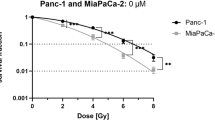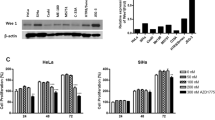Abstract
Curcumin (Diferuloylmethane) is a major chemical component of turmeric (curcuma longa) and is used as a spice to give a specific flavor and yellow color in Asian food. Curcumin exhibits growth inhibitory effects in a broad range of tumors as well as in TPA-induced skin tumors in mice. This study was undertaken to investigate the radiosensitizing effects of curcumin in p53 mutant prostate cancer cell line PC-3. Compared to cells that were irradiated alone (SF2=0.635; D0=231 cGy), curcumin at 2 and 4 μ M concentrations in combination with radiation showed significant enhancement to radiation-induced clonogenic inhibition (SF2=0.224: D0=97 cGy and SF2=0.080: D0=38 cGy) and apoptosis. It has been reported that curcumin inhibits TNF-α-induced NFκB activity that is essential for Bcl-2 protein induction. In PC-3 cells, radiation upregulated TNF-α protein leading to an increase in NFκB activity resulting in the induction of Bcl-2 protein. However, curcumin in combination with radiation treated showed inhibition of TNF-α-mediated NFκB activity resulting in bcl-2 protein downregulation. Bax protein levels remained constant in these cells after radiation or curcumin plus radiation treatments. However, the downregulation of Bcl-2 and no changes in Bax protein levels in curcumin plus radiation-treated PC-3 cells, together, altered the Bcl2 : Bax ratio and this caused the enhanced radiosensitization effect. In addition, significant activation of cytochrome c and caspase-9 and -3 were observed in curcumin plus radiation treatments. Together, these mechanisms strongly suggest that the natural compound curcumin is a potent radiosesitizer, and it acts by overcoming the effects of radiation-induced prosurvival gene expression in prostate cancer.
This is a preview of subscription content, access via your institution
Access options
Subscribe to this journal
Receive 50 print issues and online access
$259.00 per year
only $5.18 per issue
Buy this article
- Purchase on Springer Link
- Instant access to full article PDF
Prices may be subject to local taxes which are calculated during checkout








Similar content being viewed by others
References
Ahmed MM, Venkatasubbarao K, Fruitwala SM, Muthukkumar S, Wood Jr DP, Sells SF, Mohiuddin M and Rangnekar VM . (1996). J. Biol. Chem., 271, 29231–29237.
Baldwin Jr AS . (1996). Annu. Rev. Immunol., 14, 649–683.
Beg AA and Baltimore D . (1996). Science, 274, 782–784.
Bhaumik S, Anjum R, Rangaraj N, Pardhasaradhi BV and Khar A . (1999). FEBS Lett., 456, 311–314.
Bierhaus A, Zhang Y, Quehenberger P, Luther T, Haase M, Muller M, Mackman N, Ziegler R and Nawroth PP . (1997). Thromb. Haemost., 77, 772–782.
Brach MA, Hass R, Sherman ML, Gunji H, Weichselbaum R and Kufe D . (1991). J. Clin. Invest., 88, 691–695.
Chen H, Zhang ZS, Zhang YL and Zhou DY . (1999). Anticancer Res., 19, 3675–3680.
Chen HW and Huang HC . (1998). Br. J. Pharmacol., 124, 1029–1040.
Chendil D, Das A, Dey S, Mohiuddin M and Ahmed MM . (2002). Cancer Biol. Ther., 1, 152–160.
Cheng AL, Hsu CH, Lin JK, Hsu MM, Ho YF, Shen TS, Ko JY, Lin JT, Lin BR, Ming-Shiang W, Yu HS, Jee SH, Chen GS, Chen TM, Chen CA, Lai MK, Pu YS, Pan MH, Wang YJ, Tsai CC and Hsieh CY . (2001). Anticancer Res., 21, 2895–2900.
Dixon EP, Stephenson DT, Clemens JA and Little SP . (1997). Brain Res., 776, 222–229.
Dong Z, Lavrovsky V and Colburn NH . (1995). Carcinogenesis, 16, 749–756.
Dorai T, Cao YC, Dorai B, Buttyan R and Katz AE . (2001). Prostate, 47, 293–303.
Earnshaw WC, Martins LM and Kaufmann SH . (1999). Annu. Rev. Biochem., 68, 383–424.
Greenlee RT, Murray T, Bolden S and Wingo PA . (2000). CA Cancer J. Clin., 50, 7–33.
Hallahan DE, Spriggs DR, Beckett MA, Kufe DW and Weichselbaum RR . (1989). Proc. Natl. Acad. Sci. USA, 86, 10104–10107.
Hockenbery D, Nunez G, Milliman C, Schreiber RD and Korsmeyer SJ . (1990). Nature, 348, 334–336.
Huang MT, Lou YR, Xie JG, Ma W, Lu YP, Yen P, Zhu BT, Newmark H and Ho CT . (1998). Carcinogenesis, 19, 1697–1700.
Huang TS, Lee SC and Lin JK . (1991). Proc. Natl. Acad. Sci. USA, 88, 5292–5296.
Inayat MS, Chendil D, Mohiuddin M, Elford HL, Gallicchio VS and Ahmed MM . (2002). Cancer Biol. Ther., 1, 539–545.
Janicke RU, Sprengart ML, Wati MR and Porter AG . (1998). J. Biol. Chem., 273, 9357–9360.
Jee SH, Shen SC, Tseng CR, Chiu HC and Kuo ML . (1998). J. Invest. Dermatol., 111, 656–661.
Jiang MC, Yang-Yen HF, Yen JJ and Lin JK . (1996). Nutr. Cancer, 26, 111–120.
Jobin C, Bradham CA, Russo MP, Juma B, Narula AS, Brenner DA and Sartor RB . (1999). J. Immunol., 163, 3474–3483.
Juo P, Kuo CJ, Yuan J and Blenis J . (1998). Curr. Biol., 8, 1001–1008.
Khar A, Ali AM, Pardhasaradhi BV, Begum Z and Anjum R . (1999). FEBS Lett., 445, 165–168.
Kuida K, Haydar TF, Kuan CY, Gu Y, Taya C, Karasuyama H, Su MS, Rakic P and Flavell RA . (1998). Cell, 94, 325–337.
Kuo ML, Huang TS and Lin JK . (1996). Biochim. Biophys. Acta, 1317, 95–100.
Mehta K, Pantazis P, McQueen T and Aggarwal BB . (1997). Anticancer Drugs, 8, 470–481.
Mohandas KM and Desai DC . (1999). Indian J. Gastroenterol., 18, 118–121.
Mow BM, Blajeski AL, Chandra J and Kaufmann SH . (2001). Curr. Opin. Oncol., 13, 453–462.
Mukhopadhyay A, Bueso-Ramos C, Chatterjee D, Pantazis P and Aggarwal BB . (2001). Oncogene, 20, 7597–7609.
Ohta T, Kinoshita T, Naito M, Nozaki T, Masutani M, Tsuruo T and Miyajima A . (1997). J. Biol. Chem., 272, 23111–23116.
Piwocka K, Zablocki K, Wieckowski MR, Skierski J, Feiga I, Szopa J, Drela N, Wojtczak L and Sikora E . (1999). Exp. Cell Res., 249, 299–307.
Plummer SM, Holloway KA, Manson MM, Munks RJ, Kaptein A, Farrow S and Howells L . (1999). Oncogene, 18, 6013–6020.
Rao CV, Desai D, Rivenson A, Simi B, Amin S and Reddy BS . (1995). Cancer Res., 55, 2310–2315.
Reed JC . (1997). Cell, 91, 559–562.
Sentman CL, Shutter JR, Hockenbery D, Kanagawa O and Korsmeyer SJ . (1991). Cell, 67, 879–888.
Sharma OP . (1976). Biochem. Pharmacol., 25, 1811–1812.
Shaulian E and Karin M . (2002). Nat. Cell Biol., 4, E131–E136.
Sikora E, Bielak-Zmijewska A, Piwocka K, Skierski J and Radziszewska E . (1997). Biochem. Pharmacol., 54, 899–907.
Singh AK, Sidhu GS, Deepa T and Maheshwari RK . (1996). Cancer Lett., 107, 109–115.
Singh S and Aggarwal BB . (1995). J. Biol. Chem., 270, 24995–25000.
Tamatani M, Che YH, Matsuzaki H, Ogawa S, Okado H, Miyake S, Mizuno T and Tohyama M . (1999). J. Biol. Chem., 274, 8531–8538.
Van Antwerp DJ, Martin SJ, Kafri T, Green DR and Verma IM . (1996). Science, 274, 787–789.
Wang CY, Guttridge DC, Mayo MW and Baldwin Jr AS . (1999). Mol. Cell. Biol., 19, 5923–5929.
Wang CY, Mayo MW and Baldwin Jr AS . (1996). Science, 274, 784–787.
Wilkinson S, Gomella LG, Smith JA, Brawer MK, Dawson NA, Wajsman Z, Dai L and Chodak GW . (2002). J. Urol., 168, 2505–2509.
Acknowledgements
This work is supported by DOD PC020620 to DC.
Author information
Authors and Affiliations
Corresponding author
Rights and permissions
About this article
Cite this article
Chendil, D., Ranga, R., Meigooni, D. et al. Curcumin confers radiosensitizing effect in prostate cancer cell line PC-3. Oncogene 23, 1599–1607 (2004). https://doi.org/10.1038/sj.onc.1207284
Received:
Revised:
Accepted:
Published:
Issue Date:
DOI: https://doi.org/10.1038/sj.onc.1207284
Keywords
This article is cited by
-
Cytotoxic and radiosensitising effects of a novel thioredoxin reductase inhibitor in breast cancer
Investigational New Drugs (2021)
-
Modification of radiosensitivity by Curcumin in human pancreatic cancer cell lines
Scientific Reports (2020)
-
Radiosensitizing effect of curcumin-loaded lipid nanoparticles in breast cancer cells
Scientific Reports (2019)
-
MicroRNA-1246 regulates the radio-sensitizing effect of curcumin in bladder cancer cells via activating P53
International Urology and Nephrology (2019)
-
Phyto-polyphenols as potential inhibitors of breast cancer metastasis
Molecular Medicine (2018)



